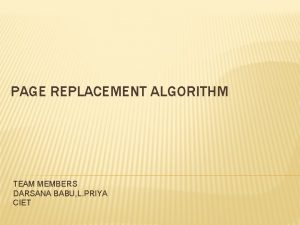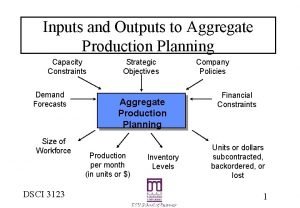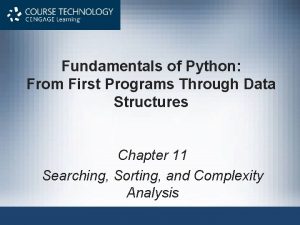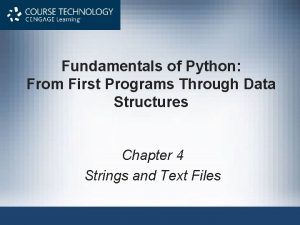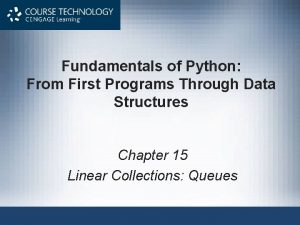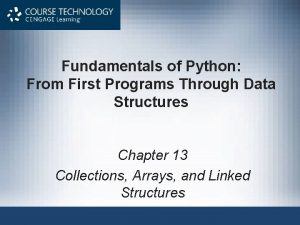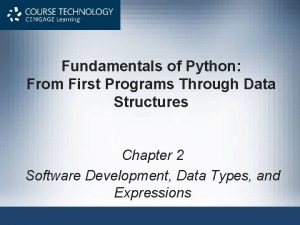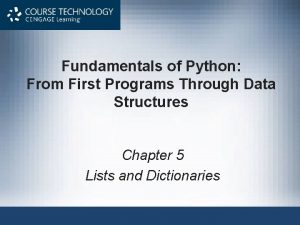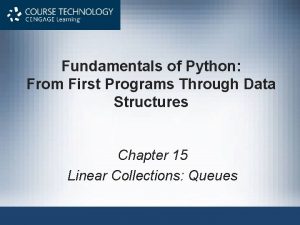Fundamentals of Python From First Programs Through Data











































- Slides: 43

Fundamentals of Python: From First Programs Through Data Structures Chapter 9 Graphical User Interfaces

Objectives After completing this chapter, you will be able to: • Structure a GUI-based program using the model/view/controller pattern • Instantiate and lay out different types of window objects, such as labels, entry fields, and command buttons, in a window’s frame • Define methods that handle events associated with window objects • Organize sets of window objects in nested frames Fundamentals of Python: From First Programs Through Data Structures 2

Introduction • Most modern computer software employs a graphical user interface or GUI • A GUI displays text as well as small images (called icons) that represent objects such as directories, files of different types, command buttons, and dropdown menus • In addition to entering text at keyboard, the user of a GUI can select an icon with pointing device, such as mouse, and move that icon around on the display Fundamentals of Python: From First Programs Through Data Structures 3

The Behavior of Terminal-Based Programs and GUI-Based Programs • Two different versions of the bouncy program from a user’s point of view: – Terminal-based user interface – Graphical user interface • Both programs perform exactly the same function – However, their behavior, or look and feel, from a user’s perspective are quite different Fundamentals of Python: From First Programs Through Data Structures 4

The Terminal-Based Version Fundamentals of Python: From First Programs Through Data Structures 5

The Terminal-Based Version (continued) • Problems: – User is constrained to reply to a definite sequence of prompts for inputs • Once an input is entered, there is no way to change it – To obtain results for a different set of input data, user must wait for command menu to be displayed again • At that point, the same command all of the other inputs must be re-entered – User can enter an unrecognized command Fundamentals of Python: From First Programs Through Data Structures 6

The GUI-Based Version • Uses a window that contains various components – Called window objects or widgets A label An entry field A command button Title bar Can be dragged to resize window • Solves problems of terminal-based version Fundamentals of Python: From First Programs Through Data Structures 7

Event-Driven Programming • User-generated events (e. g. , mouse clicks) trigger operations in program to respond by pulling in inputs, processing them, and displaying results – Event-driven software – Event-driven programming Fundamentals of Python: From First Programs Through Data Structures 8

Event-Driven Programming (continued) • Coding phase: – Define a new class to represent the main window – Instantiate the classes of window objects needed for this application (e. g. , labels, command buttons) – Position these components in the window – Instantiate the data model and provide for the display of any default data in the window objects – Register controller methods with each window object in which a relevant event might occur – Define these controller methods – Define a main that launches the GUI Fundamentals of Python: From First Programs Through Data Structures 9

Coding Simple GUI-Based Programs • There are many libraries and toolkits of GUI components available to the Python programmer – For example, Tkinter and tk. Message. Box • Standard Python modules • Tkinter includes classes for windows and numerous types of window objects • tk. Message. Box includes functions for several standard pop-up dialog boxes Fundamentals of Python: From First Programs Through Data Structures 10

Windows and Labels • A grid layout allows programmer to place components in the cells of an invisible grid Parent component for Label object Fundamentals of Python: From First Programs Through Data Structures 11

Windows and Labels (continued) • The GUI is launched in the main method – Instantiates Label. Demo and calls mainloop • mainloop method pops up window and waits for user events – At this point, the main method quits (GUI is running a hidden, event-driven loop in a separate process) Fundamentals of Python: From First Programs Through Data Structures 12

Displaying Images • Steps to create a label with an image: – __init__ creates an instance of Photo. Image from a GIF file on disk – The label’s image attribute is set to this object Fundamentals of Python: From First Programs Through Data Structures 13

Displaying Images (continued) • The image label is placed in the grid before the text label • The resulting labels are centered in a column in the window Fundamentals of Python: From First Programs Through Data Structures 14

Command Buttons and Responding to Events Fundamentals of Python: From First Programs Through Data Structures 15

Command Buttons and Responding to Events (continued) • A button can display either text or an image • To activate a button and enable it to respond to clicks, set command to an event-handling method – In this case, _switch examines the text attribute of the label and sets it to the appropriate value • Attributes are stored in a dictionary Fundamentals of Python: From First Programs Through Data Structures 16

Viewing the Images of Playing Cards Fundamentals of Python: From First Programs Through Data Structures 17

Entry Fields for the Input and Output of Text • A form filler consists of labeled entry fields, which allow the user to enter and edit a single line of text • A field can also contain text output by a program • Tkinter’s Entry displays an entry field • Three types of data container objects can be used with Entry fields: Fundamentals of Python: From First Programs Through Data Structures 18

Entry Fields for the Input and Output of Text (continued) Fundamentals of Python: From First Programs Through Data Structures 19

Using Pop-up Dialog Boxes Fundamentals of Python: From First Programs Through Data Structures 20

Using Pop-up Dialog Boxes (continued) Fundamentals of Python: From First Programs Through Data Structures 21

Case Study: A GUI-Based ATM • Request: – Replace the terminal-based interface of the ATM program with a GUI • Analysis: – There are no new classes, although the ATM class now extends the Frame class • Design: – Instead of implementing a text-based, menu-driven command processor, ATM now implements a GUIbased, event-driven command processor • _login and _logout Fundamentals of Python: From First Programs Through Data Structures 22

Case Study: A GUI-Based ATM (continued) Fundamentals of Python: From First Programs Through Data Structures 23

Case Study: A GUI-Based ATM (continued) • Implementation (Coding): … Fundamentals of Python: From First Programs Through Data Structures 24

Other Useful GUI Resources • Layout of GUI components can be specified in more detail – Groups of components can be nested in panes • Paragraphs can be displayed in scrolling text boxes • Lists of information can be presented for selection in scrolling list boxes and drop-down menus • Color, size, and style of text and of some GUI components can be adjusted • GUI-based programs can be configured to respond to various keyboard events and mouse events Fundamentals of Python: From First Programs Through Data Structures 25

Colors • Tkinter module supports the RGB – Values expressed in hex notation (e. g. , #ff 0000) – Some commonly used colors have been defined as string values (e. g. , "white", "black", "red") • For most components, you can set two color attributes: – A foreground color (fg) and a background color (bg) Fundamentals of Python: From First Programs Through Data Structures 26

Text Attributes • The text displayed in a label, entry field, or button can also have a type font Fundamentals of Python: From First Programs Through Data Structures 27

Text Attributes (continued) • Example: Fundamentals of Python: From First Programs Through Data Structures 28

Sizing and Justifying an Entry • It’s common to restrict the data in a given entry field to a fixed length; for example: – A nine-digit number for a Social Security number Fundamentals of Python: From First Programs Through Data Structures 29

Sizing the Main Window • To set the window’s title: self. master. title(<a string>) • Two other methods, geometry and resizable, can be run with the root window to affect its sizing self. master. geometry("200 x 100") self. master. resizable(0, 0) • Generally, it is easiest for both the programmer and the user to manage a window that is not resizable – Some flexibility might occasionally be warranted Fundamentals of Python: From First Programs Through Data Structures 30

Grid Attributes • By default, a newly opened window shrink-wraps around its components and is resizable – When window is resized, the components stay shrink -wrapped in their grid • Grid remains centered within the window • Widgets are also centered within their grid cells • Occasionally, – A widget must be aligned to left/right of its grid cell, – Grid must expand with surrounding window, and/or – Components must expand within their cells Fundamentals of Python: From First Programs Through Data Structures 31

Grid Attributes (continued) Fundamentals of Python: From First Programs Through Data Structures 32

Using Nested Frames to Organize Components • Suppose a GUI requires a row of command buttons beneath two columns of labels and entry fields: • It is difficult, but not impossible, to create this complex layout with a single grid • Alternative: decompose window into two nested frames (panes), each containing its own grid Fundamentals of Python: From First Programs Through Data Structures 33

Using Nested Frames to Organize Components (continued) • The new frame is then added to its parent’s grid and becomes the parent of the widgets in its own grid Fundamentals of Python: From First Programs Through Data Structures 34

Multi-Line Text Widgets • Use Text widget to display multiple lines of text – wrap attribute CHAR (default), WORD, or NONE – Widget can expand with its cell; alternative: scroll bars • Text within a Text widget is accessed by index positions (specified as strings): "row. Number. character. Number" • insert is used to send a string to a Text widget: output. insert("1. 0", "Pythonƒrules!") output. insert(END, "Pythonƒrules! ") • delete can be used to clear a Text widget: output. delete("1. 0", END) Fundamentals of Python: From First Programs Through Data Structures 35

Multi-Line Text Widgets (continued) Fundamentals of Python: From First Programs Through Data Structures 36

Scrolling List Boxes Fundamentals of Python: From First Programs Through Data Structures 37

Scrolling List Boxes (continued) Fundamentals of Python: From First Programs Through Data Structures 38

Mouse Events Fundamentals of Python: From First Programs Through Data Structures 39

Mouse Events (continued) • Associate a mouse event and an event-handling method with a widget by calling the bind method: self. _the. List. bind("<Button. Release-1>", self. _get) • Now all you have to do is define the _get method – Method has a single parameter named event Fundamentals of Python: From First Programs Through Data Structures 40

Keyboard Events • GUI-based programs can also respond to various keyboard events: • Example: to bind the key press event to a handler self. _radius. Entry. bind("<Key. Press-Return>", lambda event: self. _area()) Fundamentals of Python: From First Programs Through Data Structures 41

Summary • A GUI-based program responds to user events by running methods to perform various tasks – The model/view/controller pattern assigns the roles and responsibilities to three different sets of classes • Tkinter module includes classes, functions, and constants used in GUI programming • A GUI-based program is structured as a main window class (extends the Frame class) • Examples of window components: labels, entry fields, command buttons, text areas, and list boxes Fundamentals of Python: From First Programs Through Data Structures 42

Summary (continued) • Pop-up dialog boxes display messages and ask yes/no question (use tk. Messagebox class) • Objects can be arranged using grids and panes • Each component has attributes for the foreground color and background color • Text has a type font attribute • The command attribute of a button can be set to a method that handles a button click • Mouse and keyboard events can be associated with handler methods for window objects (bind) Fundamentals of Python: From First Programs Through Data Structures 43
 Python subscript operator
Python subscript operator Fundamentals of python: first programs
Fundamentals of python: first programs Fundamentals of python data structures
Fundamentals of python data structures Cpmcd full form
Cpmcd full form Python about
Python about Building python programs
Building python programs Building python programs
Building python programs Java programs perform i/o through ……….. *
Java programs perform i/o through ……….. * Riverside county first time homebuyer program
Riverside county first time homebuyer program Fundamental
Fundamental By one man sin
By one man sin Dome of furcation
Dome of furcation Advantage of through and through sawing
Advantage of through and through sawing Entertainment poem
Entertainment poem What is the collection of interrelated data
What is the collection of interrelated data Programs that organize analyze and graph numerical data
Programs that organize analyze and graph numerical data Open data programs
Open data programs Algorithms + data structures = programs
Algorithms + data structures = programs Common features of software
Common features of software Fundamentals of data communication
Fundamentals of data communication Fundamentals of data and signals
Fundamentals of data and signals Fundamentals of data structures in c
Fundamentals of data structures in c Fundamentals of data and signals
Fundamentals of data and signals Data domain fundamentals
Data domain fundamentals Data warehouse fundamentals
Data warehouse fundamentals Fundamentals of data structure in c
Fundamentals of data structure in c Cardinality and modality in database
Cardinality and modality in database Numeric data types in python
Numeric data types in python Python algebraic data types
Python algebraic data types Data mining tutorial python
Data mining tutorial python Tipe data python
Tipe data python Advanced data structures in python
Advanced data structures in python Graph data structure python
Graph data structure python The maturity continuum 7 habits
The maturity continuum 7 habits Breadth vs depth search
Breadth vs depth search Sdl first vs code first
Sdl first vs code first Put first things first activities
Put first things first activities Habit 3 put first things first
Habit 3 put first things first Entity framework 7 release date
Entity framework 7 release date First to invent or first to file
First to invent or first to file First in first out
First in first out![Stack=[] digunakan untuk memebuat stack dengan Stack=[] digunakan untuk memebuat stack dengan](data:image/svg+xml,%3Csvg%20xmlns=%22http://www.w3.org/2000/svg%22%20viewBox=%220%200%20200%20200%22%3E%3C/svg%3E) Stack=[] digunakan untuk memebuat stack dengan
Stack=[] digunakan untuk memebuat stack dengan First in first out
First in first out First come first serve
First come first serve
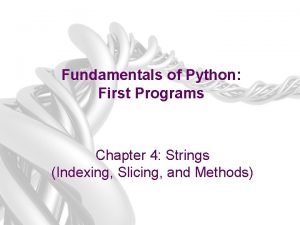
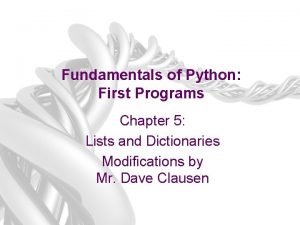


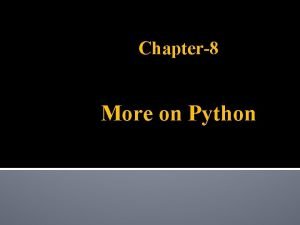
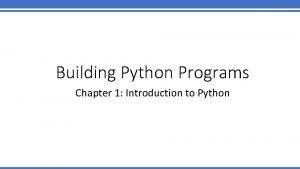
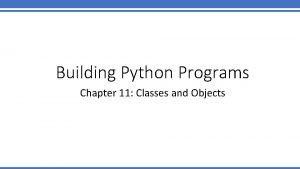
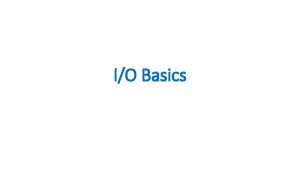
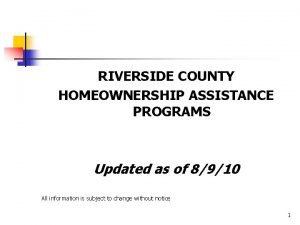





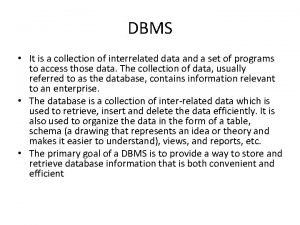
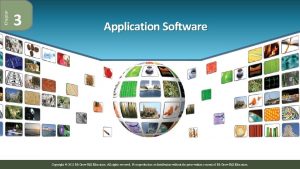
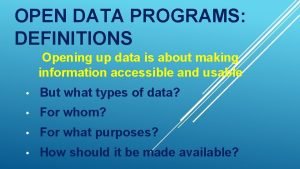

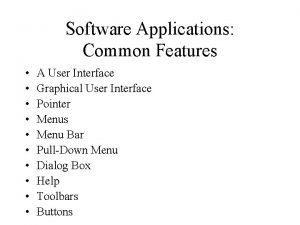
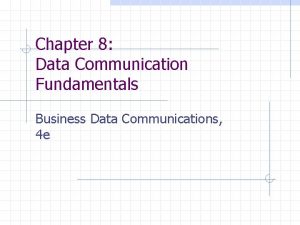
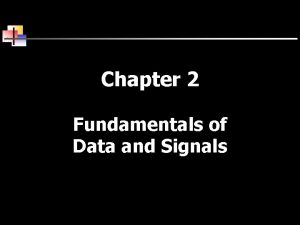
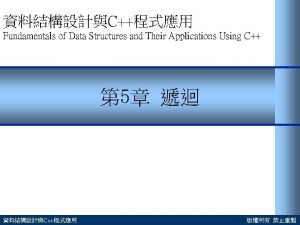
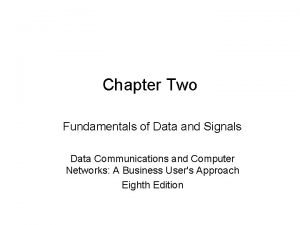

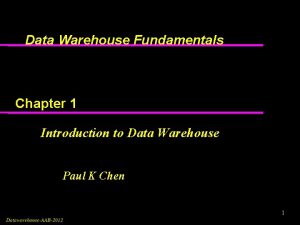


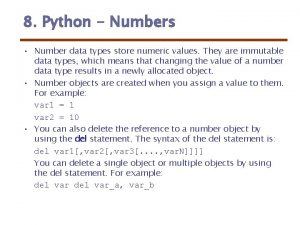
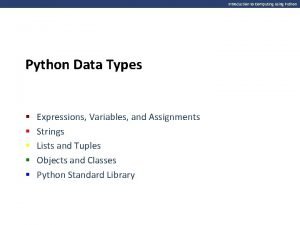
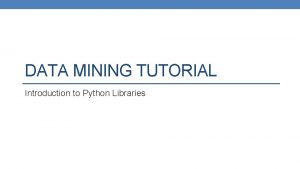
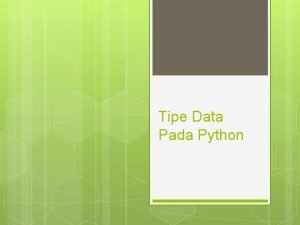
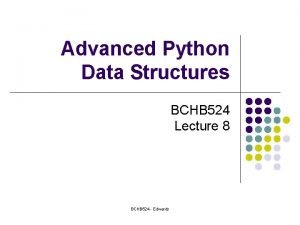
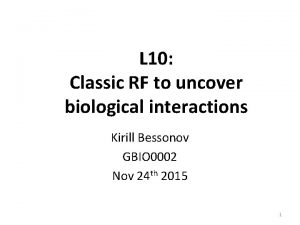


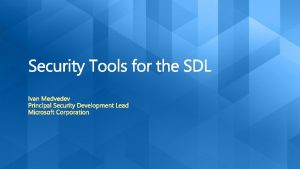


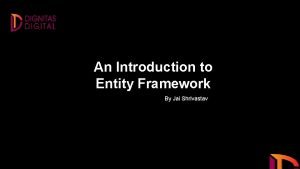

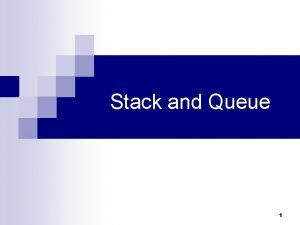
![Stack=[] digunakan untuk memebuat stack dengan Stack=[] digunakan untuk memebuat stack dengan](https://slidetodoc.com/wp-content/uploads/2020/10/1003988_042512bb86e3aab910dfb86ac5697e60-300x212.jpg)
